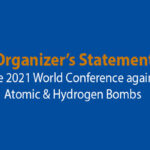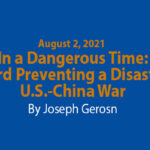August 2, 2021
World Conference Against A & H Bombs–(Gensuikyo)
By Achin Vanaik
1. While it is obvious that India as a declared nuclear power is not willing on its own to join the TPNW how can anti-nuclear activists and movements in India push it in this direction through promotion of nuclear restraint and disarmament measures, regional and global?
2. The first stage is to generate in various ways and activities as much public awareness as possible about the evils of nuclear weapons (NWs) for it is when this effort achieves a critical mass that it becomes possible to exercise enough pressure on the government to carry out desired policy changes. In this regard there is an important difference between the populace in advanced countries like US, Western Europe, Japan and in developing countries like India. In the former, substantial sections of the middle classes, because they are materially speaking fairly comfortable, can become seriously concerned with foreign policy matters concerning the dangers of nuclear rivalries and therefore involved in anti-nuclear movements. In India the vast majority of the population are preoccupied with basic livelihood issues of survival and comfort, so the nuclear question remains much more distant from their mind.
3. We recognize this reality even as we continue our efforts to generate greater opposition to NWs in India and elsewhere. Here, our awareness raising strategy incorporate the following themes.
(i) We highlight the financial and economic wastefulness, indeed criminality of the huge expenditures on maintaining and deploying the nuclear arsenal when such funds should be diverted to addressing basic needs of food availability, healthcare, education, social security, etc.
(ii) Since there are already mass mobilisations and anger against nuclear energy plans and plants, uranium mining, waste disposal sites, etc in different parts of the country, generating greater consciousness of the dangers posed by NWs in these struggles is very important. Both NWs and nuclear energy are therefore opposed by the Coalition for Nuclear Disarmament and Peace (CNDP), the National alliance of Anti-Nuclear Movements (NAAM) and the Indian Doctors for Peace and Democracy (IDPD) which is the Indian section of the IPPNW.
(iii) The South Asian situation is uniquely dangerous because of the continuous hot-cold war between India and Pakistan. The likelihood of a military conflict between them escalating to the nuclear level is all too real and greater than anywhere else in the world. We therefore have to push for certain restraint measures that make sense not only to the public in both countries but also to outside governments so as to increase the pressure for their acceptance. Two such proposals are a) setting up a de-militarised zone on both sides of the Indo-Pakistan border overseen by international observers such as the already existing UN Military Observers Group for India-Pakistan (UNMOGIP). b) Neither country deploys its nuclear hardware/software in their respective areas of Kashmir so we should press for declaring Kashmir on both sides a Nuclear Weapons Free Zone (NWFZ). This has no operational costs for either government and can be their diplomatic riposte to outside governments claiming South Asia as the world’s worst nuclear flashpoint!. As it is, one party in Pakistan, the All Jammu & Kashmir Muslim Conference has in the past supported this call.
4. What about the India-China conflict? This is basically a border dispute which can be solved by territorial give-and-take by both countries. The main obstacle, however, is the US policy of containing China through different alliance structures including the Quad comprising US-Japan-India-Australia. This is where joint activity and opposition by Civil Society Organisations in these four and other countries against the militarisation of the Pacific and Indian Ocean waters can play a positive role.
Furthermore, even as India and China are Nuclear Weapons States (NWSs) they are the only two that have adopted a No First Use (NFU) policy. We should press these two along with some other non-nuclear weapons states (NNWSs) to consider organising an international conference calling on the other NWSs to adopt NFU and an unequivocal non-use ever on non-nuclear weapons free states (NNWSs). In fact, China and Russia have established a bilateral NFU pact.
Incidentally, if the Biden Presidency can be pushed to ratify the CTBT, not only will China follow suit but India and Pakistan will immediately join this treaty signing and ratifying it.
5. Finally, let us recognize that the India-Pakistan nuclear face-off threatens all the governments and peoples of South Asia. But only one country in the region, Bangladesh, has signed and ratified the TPNW. Its government as well as activist groups in its society have publicly criticized this nuclearisation. This is why it is the one government that should be approached by representatives from the Nobel prize-winning bodies of ICAN and IPPNW (which has a Bangladesh chapter) as well as from major anti-nuclear organisations elsewhere. Bangladesh can be seriously persuaded to consider applying for membership of an extended Bangkok Treaty (Southeast Asian NWFZ) or move towards a Single State NWFZ status like Mongolia. Either development would be a major political step forward towards promoting greater nuclear sanity in South Asia and the world


